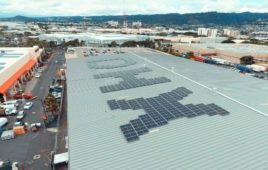REC Solar, an unregulated affiliate of Duke Energy, has completed a solar microgrid solution for ocean and air freight company DHX (Dependable Hawaiian Express).
The vision for renewable generation combined with energy storage as a backup power supply came long before DHX opened its environmentally friendly facility in Honolulu last August.
“When your company’s first name is ‘dependable,’ you better have a power system that is too,” said DHX President Brad Dechter. “Still, my commitment to going green isn’t just about reliable energy and saving money. I have a granddaughter who is seven, and it’s as much about saving the planet for her future. The key for me was finding the right expert.”
“DHX wanted an emissions-free solution that would complement their commitment to customer service and ensure business continuity – even during a power outage,” said Dan Alcombright, senior vice president of REC Solar. “Providing innovative, resilient, clean energy solutions to our customers is what we do best.”
REC Solar designed, engineered and installed a 133-kW solar system on the 76,000-sq-ft roof of DHX’s new warehouse and distribution center in Honolulu. The solar generation is combined with 222 kWh of energy storage, a microgrid controller and other equipment. The result is a zero-emissions energy system that protects DHX’s sensitive electronic equipment and provides up to four hours of backup power during outages. The microgrid enables a graceful shutdown and smooth transition from grid power during electric outages.
“Avoiding costs from damaged computers, servers and other equipment could in itself pay for the system,” Dechter noted. “And using the energy we produce on-site is a great way to shift load, reduce my peak usage and lower year-round demand charges. That cuts costs year-round.
“I like the package REC put together as it allows us flexibility and coverage we need at the best value,” added Dechter. “And the solar panels on the roof spell out DHX – a great way to promote our business to those traveling by plane or helicopter over the shipping and warehouse districts.”
With the first phase of the project completed, the next phase includes the installation of more solar on the alternate side of the roof. The additional clean energy will provide electric vehicle charging capacity for the company’s planned transition to electric vehicles (EV) in the future.






